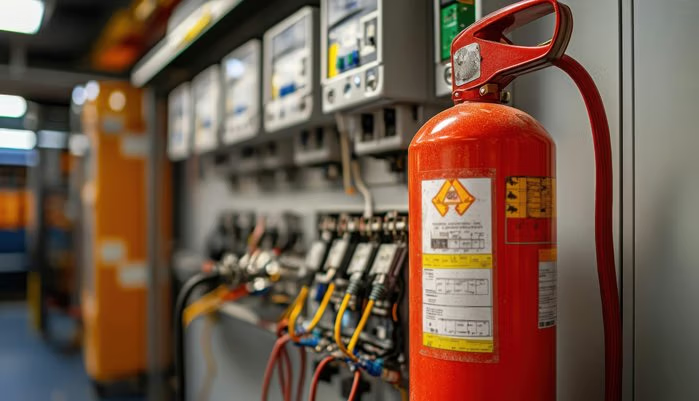Summary: Establishing a work environment is crucial for companies to safeguard their employees and adhere to the Occupational Safety and Health Administration (OSHA) guidelines. Conducting self-assessments using checklists is an effective method to pinpoint potential risks reduce hazards and uphold OSHA standards. Let’s delve into a manual, on self-inspection checklists for safety addressing various areas of concern and offering practical steps to tackle safety issues.
Recognizing the Significance of Workplace Safety
Ensuring workplace safety goes beyond being an obligation; it is fundamental for employees well being and the prosperity of businesses. Incidents and injuries can profoundly impact both individuals and companies.
The Implications of Workplace Accidents on Companies
Workplace mishaps can lead to setbacks, heightened insurance costs, legal responsibilities, and harm to a firm’s reputation. The expenses linked with accidents encompass bills, compensation claims, property destruction, and potential legal fines. Furthermore, accidents can result in reduced efficiency and employee morale issues. Diminished trust from customers.
OSHA Responsibility in Upholding Workplace Safety
The Occupational Safety and Health Administration (OSHA) functions as a body that establishes and enforces safety protocols, in work environments. OSHA strives to prevent job-related injuries, illnesses, and fatalities by advocating for working conditions. OSHA carries out inspections provides training and educational materials and enforces penalties for not following safety guidelines.
Is your safety strategy keeping pace with evolving challenges?
Enhance your safety protocols with our advanced EHS software
Crafting a Workplace Safety Self-Inspection Checklist
Developing a practical self-inspection checklist necessitates careful consideration of your industry and workplace environment. A well-structured checklist plays a crucial role in workplace injury prevention by proactively identifying hazards and ensuring compliance with safety protocols. To assist you in this process, below are the steps to create a checklist tailored specifically to your organization’s requirements.
Understanding Your Industry and Workplace
Each industry has its safety needs and potential dangers. It is essential to comprehend the risks associated with your industry while taking into account the nature of your workplace. For instance, manufacturing facilities may face safety issues compared to office settings. Conduct an evaluation of your workplace, including equipment, processes, and tasks performed.
Referring to Guidelines and Regulations
OSHA offers guidelines and regulations for various industries. Firstly, it is important to familiarize yourself with the OSHA standards specific to your industry. By doing so, you can gain valuable insights into the safety precautions and controls that businesses should adopt. Furthermore, integrating OSHA requirements into your self-inspection checklist is essential to ensure compliance.
Engaging employees in the process of creating checklists
Employees often have an eye for safety issues in the workplace. Moreover, involving them in developing self-inspection checklists can offer valuable perspectives and insights. To accomplish this, it is crucial to encourage employee participation through feedback sessions, interviews, or safety committee collaborations. By doing so, their contributions will greatly help shape a relevant and efficient checklist.
Advantages of Self-Inspection Checklists
Self inspection checklists are tools, for upholding safety standards and complying with OSHA regulations. They offer advantages to businesses. Help instill a culture of safety within the company.
Spotting and dealing with dangers
Using a self-inspection checklist allows businesses to systematically evaluate their work environment for hazards. By identifying and addressing these hazards companies can prevent accidents and injuries before they happen.
Encouraging a focus on safety
self-inspections using checklists show a dedication to maintaining safety. By involving employees in the inspection process and encouraging their involvement businesses can promote a culture of safety.
Minimizing the likelihood of accidents and injuries
Self-inspections help companies swiftly identify and resolve safety concerns. Addressing these issues promptly significantly reduces the risk of accidents and injuries. Implementing safety measures such, as equipment maintenance, ongoing training, and hazard identification contributes to creating a safer workplace environment for employees.
Ensuring Compliance, with OSHA
Adhering to OSHA regulations is not just an obligation but a crucial element of workplace safety. Utilizing self-inspection checklists assists organizations in ensuring they adhere to OSHA standards and criteria. By reviewing and adjusting these checklists based on OSHA guidelines companies can showcase their dedication to compliance. Mitigate the risk of penalties or citations during official inspections.
Customizing the checklist to suit your workplace requirements
Avoid using checklists that may not address the unique hazards and risks present in your workplace. Tailor the checklist to align with your organization’s characteristics and needs. Consider factors such as facility layout, equipment usage, task types, and industry-specific regulations when customizing the checklist. A personalized checklist ensures coverage of areas while focusing on critical safety considerations.
Essential Areas to Cover in Your Workplace Safety Self-Inspection Checklist
A self-inspection checklist for safety should encompass various aspects for a thorough evaluation. Here are some key areas to incorporate when crafting your checklist;
Overall Safety
Establishing general safety protocols is fundamental for fostering a work environment. Include the following items, in your checklist;
- The exits clearly marked and easily accessible?
- Do the fire alarms and emergency lighting work
- Have the employees received training, on what to do in case of an emergency and know the evacuation routes?
- Safety signs visibly placed in areas?
Electrical Safety
Extension cords and power strips in good shape and used correctly?
Are outlets and switches adequately protected?
Qrounding ensured for all systems?
Are cables free from fraying or exposed wires?
Are all connections secure, with insulation?
Fire Safety
Fire hazards can lead to consequences. Make sure your workplace is safe, from fires, by checking these points;
- Check fire extinguishers: Are they easy to reach and regularly checked?
- Verify fire alarm systems and emergency exits: Ensure they work are. Employees know evacuation procedures.
- Take precautions with materials: Store them properly enforce smoking policies and watch out for fire hazards.
- Handle materials safely: Store them in labeled containers and keep incompatible materials apart to avoid chemical reactions.
- PPE Safety: Are employees provided with the protective equipment (PPE) when handling hazardous materials? Is the PPE well-maintained and in good condition? Have employees received training on how to use and dispose of PPE?
Hazardous Materials Handling and Storage
For workplaces with machinery and equipment safety should be a priority. Include the following items in your machinery and equipment safety checklist;
- Maintenance and inspections: Are machinery and equipment routinely inspected for signs of wear, damage, or malfunctions? Are repairs and maintenance tasks carried out by individuals?
- Machine guarding and lockout/tagout procedures: Are machine guards installed correctly and operational? Have employees received training on lockout/tagout procedures to prevent accidental machine startup during maintenance activities? Are warning signs and labels visibly displayed on machinery?
- Operator training and certification: Have operators undergone training and certification for operating machinery and equipment? Is there a system, in place to maintain training records?
Do operators know, about the safety features and potential risks associated with the equipment they use?
Personal Protective Equipment (PPE)
The use of PPE is essential to ensure the safety of employees in work environments. Here are some key points to include in your PPE checklist;
- Are employees equipped with the PPE for their tasks?
- Do employees consistently and properly wear their PPE?
- All PPE items in good condition and regularly checked?
- Do employees know how to maintain and clean their PPE?
- Is there a process in place for replacing damaged or worn-out PPE?
- Do employees participate in these assessments?
- Are changes in tasks or workplace conditions taken into account when assessing the need, for more PPE?
Workplace Ergonomics
Ergonomic practices promote employee well-being and prevent musculoskeletal disorders. Include the following in your workplace ergonomics checklist:
Proper workstation setup and ergonomics
- Are workstations designed ergonomically, considering factors such as desk height, chair adjustability, and monitor positioning?
- Are employees provided with ergonomic tools and equipment, such as adjustable keyboards or standing desks?
Training on ergonomic practices
- Are employees educated on the importance of ergonomic practices?
- Do employees know how to identify and report ergonomic issues or discomfort?
- Are there guidelines and resources available to help employees implement ergonomic strategies?
Preventing musculoskeletal disorders
- Are job tasks analyzed for potential ergonomic risks?
- Are measures in place to reduce repetitive motions or heavy lifting?
Safety Training and Communication
Practical safety training and communication ensure employees are knowledgeable and engaged in workplace safety. Consider the following in your safety training and communication checklist:
Initial safety orientation for new employees
- Do new employees receive a comprehensive safety orientation before starting their tasks?
- Are they educated on general safety policies, emergency procedures, and hazard awareness?
- Do they receive specific training related to their job tasks and potential hazards?
Ongoing safety training
- Are regular safety training sessions conducted for all employees?
- Do the training sessions cover new safety procedures, regulation changes, and emerging risks?
- Are refresher courses provided to reinforce essential safety practices?
Safety communication channels
- Is there a clear and accessible method for employees to report safety concerns or incidents?
- Are there regular safety meetings or newsletters to inform employees about safety updates?
Emergency preparedness and response
- Do employees know how to respond to emergencies like fires, chemical spills, or medical incidents?
- Are evacuation routes, assembly points, and emergency contact information posted?
Safety signage and labeling
- Are safety signs and labels prominently displayed throughout the workplace?
- Are hazardous areas, equipment, or substances marked with appropriate warning signs?
- Are safety instructions and procedures clearly labeled on machinery or equipment?
Feedback and evaluation
- Is there a system to gather employee feedback regarding safety practices?
- Are safety audits or inspections conducted to assess compliance and identify areas for improvement?
Conducting a Workplace Safety Self-Inspection
Establishing a self-inspection schedule
Establishing a self-inspection schedule is essential for maintaining regular workplace safety inspections. Additionally, it is crucial to determine the frequency of these inspections, taking into account several factors such as the nature of your workplace, the level of risk involved, and any legal or regulatory requirements. Moreover, consider conducting inspections on a monthly, quarterly, or annual basis, depending on the size and complexity of your operations. By carefully considering these aspects, you can ensure a systematic and comprehensive approach to workplace safety.
Assigning responsibilities and roles
Firstly, designate individuals or a team responsible for conducting the self-inspections. It is crucial that these individuals possess a good understanding of workplace safety practices and are well acquainted with the hazards present in their workplace. Moreover, it is essential to clearly communicate their roles and responsibilities, including the specific areas or aspects they will be inspecting.
Conducting thorough inspections
During the self-inspection, ensure that all relevant areas, equipment, and processes is inspect thoroughly . Follow the checklists outlined earlier to guide the inspection process. Pay close attention to potential hazards, safety equipment, emergency exits, storage areas, and any other specific areas or processes that pose risks to employees’ health and safety.
Documenting findings and implementing corrective actions
Document the findings of each self-inspection, taking into account any safety issues or hazards that have been identified. Additionally, for every discovery, it is vital to determine the appropriate corrective actions and devise a plan to address them promptly. Furthermore, assign responsibility for implementing disciplinary actions and establish deadlines for their completion. Lastly, record all inspections, findings, and actions undertaken for future reference and ensure proper follow-up.
FAQ | Workplace Safety Self Inspection Checklists
What is a workplace self-inspection checklist?
A workplace self-inspection checklist is a structured tool used to systematically identify potential hazards, ensure compliance with safety regulations, and promote a proactive safety culture. By conducting regular self-inspections, businesses can prevent workplace incidents and improve overall safety.
What should be included in a workplace self-inspection checklist?
- Fire safety equipment and emergency exits
- Machinery and equipment conditions
- Personal protective equipment (PPE) usage
- Slip, trip, and fall hazards
- Electrical safety compliance
- General housekeeping and organization
- Safety training and awareness
Can I use a generic checklist, or should it be tailored to my workplace?
While generic checklists can provide a starting point, it is highly recommended to tailor the checklist to your specific workplace. Each workplace has unique hazards and safety requirements that a generic checklist may not adequately cover. Customize the checklist to address the risks and safety measures relevant to your workplace.
How often should workplace safety self-inspections be conducted?
The frequency of workplace safety self-inspections depends on various factors, including the nature of your workplace, the level of risk involved, and any legal or regulatory requirements. Generally, inspections can be conducted monthly, quarterly, or annually. Assess the specific needs of your workplace and establish a self-inspection schedule that ensures regular and thorough inspections.
How can employees be encouraged to actively participate in self-inspections?
Encourage involvement by:
- Assigning different employees to lead inspections
- Recognizing and rewarding proactive safety behavior
- Using workplace safety quotes to highlight the importance of vigilance
- Providing ongoing training on how to identify hazards and report them effectively
How can involving employees in the self-inspection process contribute to workplace safety?
Involving employees in the self-inspection process can significantly contribute to workplace safety. Employees often have firsthand knowledge of potential hazards, as they are directly involved in the day-to-day operations. You tap into their expertise and gain valuable insights by encouraging their active participation. In addition, applying employees creates a sense of ownership and responsibility for workplace safety, fostering a culture where everyone actively identifies and addresses safety concerns. This collaborative approach can lead to increased awareness, improved hazard identification, and the implementation of effective safety measures, ultimately creating a safer work environment for all.
What should I do if I discover safety issues during an inspection?
If safety issues are discovered during a self-inspection, it is essential to take prompt action. Document the findings and determine appropriate corrective actions. Assign responsibility for implementing the disciplinary actions and establish deadlines for completion. Regularly follow up on the progress of disciplinary actions and ensure that identified safety issues are effectively addressed.
Should incident reports be used to improve workplace safety self-inspection checklists?
Yes, analyzing incident reports can provide valuable insights for refining workplace safety self-inspection checklists. Patterns in reported incidents help identify recurring hazards, gaps in safety protocols, and areas requiring stricter inspection criteria. By incorporating lessons learned from incident reports, self-inspection checklists can be continuously improved to prevent future workplace injuries and enhance overall safety compliance.
Are any resources available to assist with developing self-inspection checklists?
Yes, there are resources available to assist with developing self-inspection checklists. Government agencies, industry associations, and safety organizations often provide guidelines and sample checklists to be used as a reference. Additionally, consulting with safety professionals or engaging external experts can provide valuable insights and assistance in developing comprehensive self-inspection checklists.
Image: Adobe Stock – Copyright: © Richelle – stock.adobe.com





